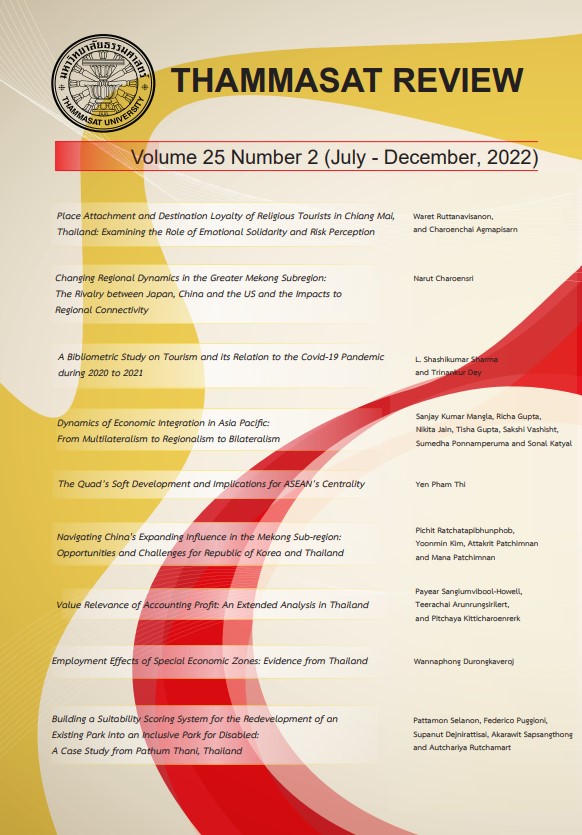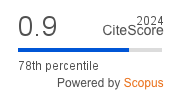Building a Suitability Scoring System for the Redevelopment of an Existing Park into an Inclusive Park for Disabled: Case Studies from Pathum Thani, Thailand
Keywords:
Inclusivity, Accessibility, Green Public Space, Urban Development, Thaklong – KlongluangAbstract
The northern fringes of the Bangkok urban area show common traits in terms of urban physical layout, social composition, urban development processes. Specifically, these territories have in common their progressive loss of agricultural activities, the urbanisation, the presence of industries and educational institutions, the daily commuting towards Bangkok’s core, the car dependency (Likitsawat and Sahavacharin, 2022); all these factors influence the quality of life of these rapidly growing territories, and consequently, their inclusivity. This article investigates in detail the need of inclusive accessible green spaces in one of these peripheral areas, Thaklong – Klongluang-Rangsit in the Pathum Thani Province. Here, the actual dotation of public parks is reduced and concentrated in six locations not connected among themselves. The need of a change of paradigm in the concept of “inclusive parks” affects not only the urban policies, but diverse aspects of the landscape discipline: the integration with the surroundings, the accessibility, the perception and the interpretation of the ideas of disability and self-use – especially the disabled, the detail design of the spaces. The main objective of this research is the analysis of the six parks in Thaklong–Klongluang-Rangsit with the Suitability Scoring System (SSS), an index developed in this article and valid for other comparable urban contexts, which includes a diagrammatic visualisation of the results. The analysis, based on physical and urban considerations, will provide a score, rating of the likeability for a specific park to be developed and improved in terms of inclusivity and accessibility for the disability carriers. The discussions will provide points useful to analyse and develop other parks in similar peri-urban areas in Bangkok and similar contexts.
References
American Planning Association (APA). (2006). Planning and Urban Design Standards, New Jersey, John Wiley & Sons.
Amini-Behbahani, P., Meng, L., & Gu, N. (2020). Walking distances from services and destinations for residential aged-care centers in Australian cities. Journal of Transport Geography, 85. https://doi.org/10.1016/j.jtrangeo.2020.102707
Australian Institute of Health and Welfare. (2019). People with disability in Australia. Australian Institute of Health and Welfare. DOI: https://doi.org/10.25816/5ec5be4ced179. https://www.aihw.gov.au/getmedia/5f322ec4-ef63-4c43-a854-64f7a2f 55a04/aihw-dis-72-people-with-disability-in-australia-2022.pdf.aspx?inline=true
bdelhamid, M., & Elfakharany, M. (2020). Improving urban park usability in developing countries: Case study of Al-Shalalat Park in Alexandria. Alexandria Engineering Journal, 59(1), 311-321.
Boodlal, L. (2003). Accessible sidewalks and street crossings: an informational guide. United States. Federal Highway Administration. https://rosap.ntl.bts.gov/view/dot/16137
Clarke, P., J. A. Ailshire, M. Bader, J. D. Morenoff, and J. S. House. 2008. Mobility disability and the urban built environment. American Journal of Epidemiology, 168(5), 506–513.
Dizdaroglu, D. (2022). Developing Design Criteria for Sustainable Urban Parks. Journal of Contemporary Urban Affairs (JCUA), 6, 69-81. 10.25034/ijcua.2022.v6n1-7.
Dovey, K. (1999) Framing places: mediating power in built form. Routledge, London
Eskytė, I., Lawson, A., Orchard, M., & Andrews, E. (2020). Out on the streets – Crisis, opportunity and disabled people in the era of Covid-19: Reflections from the UK, ALTER, European Journal of Disability Research, 14 (2020) 329–336, https://doi. org/10.1016/j.alter.2020.07.004.
Faraci, P. (1967). Vest Pocket Parks. In SPO Planning Advisory Service. American Society of Planning Officials, 229.
Gehl, J. (2010). Cities for people. Island Press, Washington, DC
Giles-Corti, B., Broomhall, M. H., Knuiman, M., Collins, C., Douglas, K., Ng, K., Lange, A., & Donovan, R. J. (2005). Increasing walking: how important is distance to, attractiveness, and size of public open space? Am J Prev Med, Feb;28(2 Suppl 2), 169-76. DOI: 10.1016/j.amepre.2004.10.018. PMID: 15694525.
Hamdy, M, & Plaku, R. (2021). "Pocket Parks: Urban Living Rooms for Urban Regeneration". Civil Engineering and Architecture, 9(3), 747-759. DOI: 10.13189/cea.2021.090316.
Han, B., Cohen, D., & McKenzie, T. L. (2013). Quantifying the contribution of neighborhood parks to physical activity. Prev Med, Nov;57(5), 483-7. DOI: 10.1016/j.ypmed.2013. 06.021.
Jacobs, J. (1961). The Death and Life of Great American Cities. New York: Random House.
Jaszczak, A., Pochodyła, E., Kristianova, K., Małkowska, N., & Kazak, J. K. (2021). Redefinition of Park Design Criteria as a Result of Analysis of Well-Being and Soundscape: The Case Study of the Kortowo Park (Poland). Journal of Environment Research and Public Health. DOI: 10.3390/ijerph18062972. PMID: 33799383; PMCID: PMC7999615.
Jiang, B., Chang, C.-Y., & Sullivan, W. C. (2014). A dose of nature: tree cover, stress reduction, and gender differences. Landscape and Urban Planning, 132, 26–36. DOI: 10.1016/j.landurbplan.2014.08.005
Jiang, B., Mak, C. N. S., Zhong, H., Larsen, L., Webster, C. J. (2018). From Broken Windows to Perceived Routine Activities: Examining Impacts of Environmental Interventions on Perceived Safety of Urban Alleys. Frontiers in Psychology, 9(2450), 1-16. DOI: 10.3389/fpsyg.2018.02450
Jorgensen, L. J., Ellis, G. D., & Ruddell, E. (2013). Fear Perceptions in Public Parks: Interactions of Environmental Concealment, the Presence of People Recreating, and Gender. Environment and Behavior, 45(7), 803–820. https://doi.org/10.1177/0013916512446334
Kaplan, R. (1984). Impact of urban nature: a theoretical analysis. Urban Ecology, 8(1984), 189-197. https://deepblue.lib.umich.edu/bitstream/handle/2027.42/24680/0000099.pdf?sequence=1
Kaplan, R., Kaplan, S., & Ryan, R. (1998). With People in Mind- Design and Management of Everyday Nature. Washington, DC; Covelo, CA: Island Press. https://vdoc.pub/documents/with-people-in-mind-design-and-management-of-everyday-naturen6om0 kiknhie0
Kaplan, S., & Peterson, C. (1993). Health and environment: A psychological analysis. Landscape and Urban Planning, 26 (1993), 17-23. https://deepblue.lib.umich.edu/bitstream/handle/2027.42/30524/0000156.pdf;sequence=1
Kelling, G. L., & Wilson, J. Q. (1982). Broken windows. Atlantic Monthly, 249, 29–38. https://www.theatlantic.com/magazine/archive/1982/03/broken-windows/304465/
Lapham, S. C., Cohen, D. A., Han, B., Williamson, S., Evenson, K. R., McKenzie, T. L., Hillier, A., & Ward, P. (2016). How important is perception of safety to park use? A four-city survey. Urban Studies, 53(12), 2624–2636. https://doi.org/10.1177/0042098015592822
Likitsawat, F., & Sahavacharin, A. (2022). Landscape Change Analysis: Ecosystem Services in the Peri-Urban Agriculture of Bangkok. Journal of Architectural/Planning Research and Studies, 20(2), 25–37. https://doi.org/10.56261/jars.2023v20i2.249694
Merriam, D., Bality, A., Stein, J., & Boehmer, T. (2017). Improving Public Health through Public Parks and Trails: Eight Common Measures. Summary report. US Department of Health and Human Services, Centers for Disease Control and Prevention and US Department of the Interior, National Park Service. http://go.nps.gov/improving_ public_health
Ministry of Housing, Communities & Local Government (2017). Pocket Parks: Frequently Asked Questions. https://assets.publishing.service.gov.uk/government/uploads/system/uploads/attachment_data/file/846960/Pocket_Parks_-Frequently_Asked_Questions.pdf
Mohandespor, S., & Yücel, G. (2019). Evaluation of Urban Park Design Criteria in The Case of Taraqi Park (Afghanistan, Herat). Journal of Architectural Research and Development, 3(4), 1-14.
National Association of City Transportation Officials (NACTO). Urban Street Design Guide. Island Press. (2013).
National Statistics Office of Thailand (NSO). (2021). Thailand Population Statistics 2021.
Pathum Thani Provincial Social Development and Human Society Office. (2022). Integrated Project to Improve the Quality of Life of Vulnerable Households in Pathumthan Province. https://pathumthani.m-society.go.th
Perry, C. A. (1929). The neighborhood unit. Volume VII, Regional New York and Its Environs, Monograph I. New York, 1929. National Municipal Review, 18(10), 636-637.
Rantakokko, M., Iwarsson, S., Mänty, M., & Tainarantanen, R. (2012). Perceived barriers in the outdoor environment and development of walking difficulties in older people. Age and Ageing, 41(1), 118–121. https://doi.org/10.1093/ageing/afr136
Rantakokko, M., S. Iwarsson, S. Vahaluoto, E. Portegijs, A. Viljanen, & T. Rantanen. (2014). Perceived environmental barriers to outdoor mobility and feelings of loneliness among community-dwelling older people. The Journals of Gerontology, Series A 69 (12), 1562- 1568.
Reuter, T. K. (2019). Human rights and the city: Including marginalized communities in urban development and smart cities. Journal of Human Rights, 18(4), 382-402. DOI:10.1080/14754835.2019.1629887
Riddle, D. I. (2019). “How Far Can You Walk? Hidden Mobility Disabilities and Community Participation”. Working paper, Hidden Mobility Disabilities Alliance.
Selanon, P., Puggioni, F., Dejnirattisai, S. et al. (2022). Towards inclusive and accessible parks in Pathum Thani Province, Thailand. City Territ Architecture, 9(24). https://doi.org/10.1186/s40410-022-00169-y
Seymour, W. N. (1969). Small urban spaces: the philosophy, design, sociology, and politics of vest-pocket parks and other small urban open spaces. New York: New York University Press.
Sinou, M., & Gail, K. A. (2013). Parameters contributing to the design of a successful urban pocket park. PLEA2013 - 29th Conference, Sustainable Architecture for a Renewable Future, Munich, Germany 10-12 September 2013. https://www.researchgate.net/publication/260862210_Parameters_contributing_to_the_design_of_a_successful_urban_pocket_park
The Disability Discrimination Act 1992 No. 135, 1992. https://www.legislation.gov.au/Details/C2018C00125
The Trust For Public Land. (1995). Healing America's Cities: How Urban Parks Can Make Cities Safe and Healthy. Children's Environments, 12(1), 65-70. https://www.jstor.org/stable/41514966
United Nations Development Programme - Nepal Acceleration Lab (2021). Behavioural Insights and Impact Study on Pocket Park. https://www.undp.org/sites/g/files/zskgke326/files/migration/np/BI-Impact-evalutation-pocketpark-Alab.pdf. Accessed 7 September 2022.
United Nations, human settlements programme UN-Habitat (2018) SDG Indicator 11.7.1 Training module: public space. united nations human settlement programme (UN-Habitat), Nairobi
United Nations, Human Settlements Programme UN-Habitat (2020a) The New Urban Agenda. https://unhabitat.org/sites/default/files/2020/12/nua_handbook_14dec2020_2.pdf. Accessed 19 August 2022
United Nations, Human Settlements Programme UN-Habitat (2020b). World Cities Report 2020. https://unhabitat.org/sites/default/files/2020/10/wcr_2020_report.pdf.
Whyte, W. H., Jr. (1980). The social life of small urban spaces. Washington, D.C.: Conservation Foundation.
Yang, Y., & Diez-Roux, A. V. (2012). Walking distance by trip purpose and population subgroups. Am J Prev Med, 43(1), 11-9. DOI: 10.1016/j.amepre.2012.03.015.
Downloads
Published
How to Cite
Issue
Section
License
Copyright (c) 2022 Thammasat Review

This work is licensed under a Creative Commons Attribution-NonCommercial-NoDerivatives 4.0 International License.
The opinions and ideas expressed in all submissions published in Thammasat Review are solely that of the author(s) and do not necessarily reflect that of the editors or the editorial board.
The copyright of all articles including all written content and illustrations belong to Thammasat Review. Any individuals or organisation wishing to publish, reproduce and distribute a particular manuscript must seek permission from the journal first.








